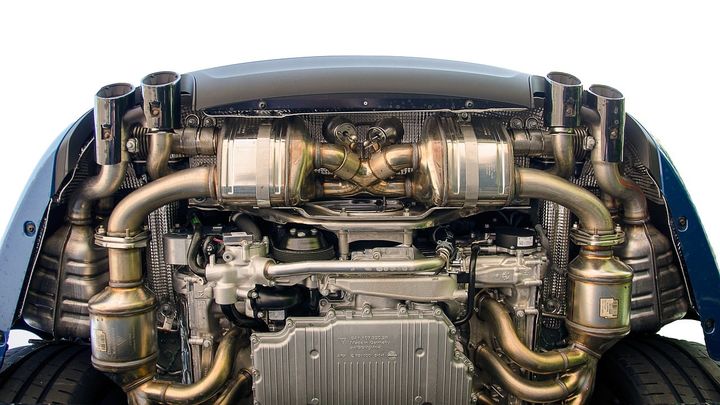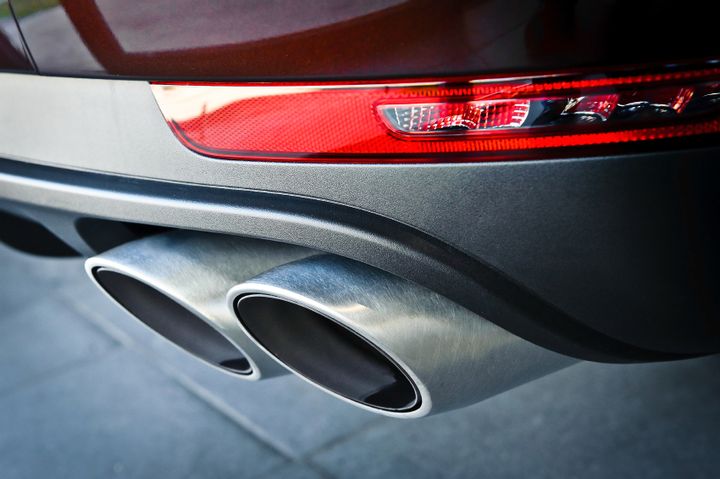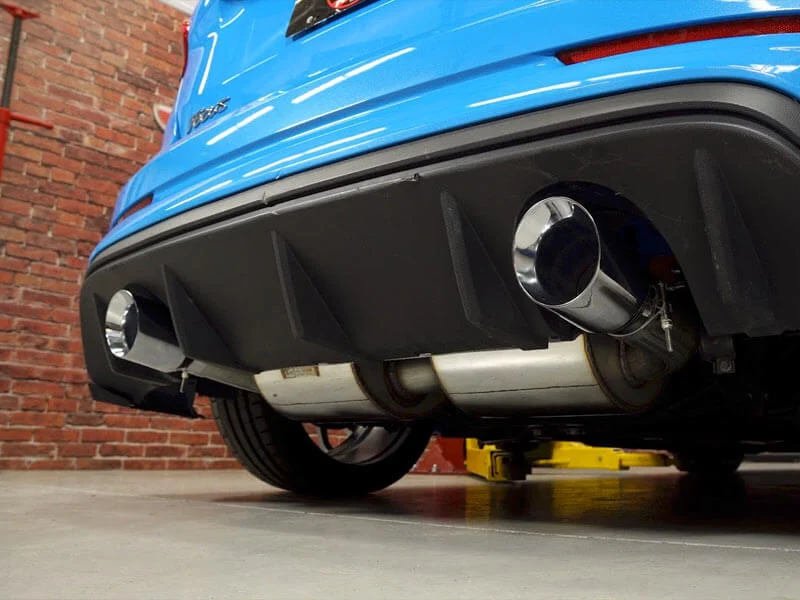


The exhaust system is a crucial component in modern vehicles, responsible for expelling the byproducts of the combustion process from the engine. Its origins can be traced back to the late 19th century when the first automobiles were developed. As concerns over air pollution and environmental impact grew, exhaust systems evolved to incorporate emission control technologies.

Before we dive into the nitty-gritty details, let's establish a solid foundation by defining the key terms:
| Term | Definition |
|---|---|
| Single Exhaust System | The most common exhaust configuration found in most vehicles. It utilizes a single exhaust pipe to channel the exhaust gases from the engine's cylinders to the rear of the vehicle, where they are expelled through a single tailpipe. |
| Dual Exhaust System | Employs two separate exhaust pipes that run parallel from the engine to the rear of the vehicle, culminating in two distinct tailpipes. |
| Split Exhaust System | Often used interchangeably with "dual exhaust," but it specifically refers to a system where a single exhaust pipe splits into two separate pipes, typically near the rear of the vehicle, resulting in two tailpipes. |
Now that we've established the basics, let's explore the primary benefits of opting for a dual or split exhaust system over a traditional single exhaust configuration.
One of the most significant advantages of dual and split exhaust systems is their ability to reduce back pressure within the engine. In a single exhaust system, all the exhaust gases from the engine's cylinders are funneled through a single pipe, which can create significant resistance or back pressure. This back pressure can limit the engine's ability to efficiently expel exhaust gases, potentially reducing power output and fuel efficiency.
By splitting the exhaust gases between two pipes, as in the case of dual and split exhaust systems, the back pressure on the engine is significantly reduced, allowing it to "breathe" more freely. This improved exhaust flow translates into increased engine power, torque, and overall efficiency.
Another notable benefit of dual and split exhaust systems is the improved scavenging effect they provide. The scavenging effect refers to the efficient expulsion of exhaust gases from the engine's cylinders during the exhaust stroke. With two separate exhaust pipes, the exhaust gases can exit the cylinders more rapidly, creating a vacuum that helps draw in fresh air for the next combustion cycle.
This enhanced scavenging effect not only contributes to increased engine power and torque but also improves fuel efficiency by ensuring more complete combustion of the air-fuel mixture within the cylinders.
While not necessarily a performance-related advantage, many car enthusiasts appreciate the distinctive exhaust note produced by dual and split exhaust systems. The dual tailpipes often emit a deeper, more resonant exhaust tone that can add to the overall driving experience and auditory appeal of the vehicle.
Regardless of whether your vehicle is equipped with a single, dual, or split exhaust system, regular inspections and maintenance are crucial to ensure optimal performance and longevity. Here are some steps I recommend for inspecting and diagnosing potential exhaust system issues:
Start by conducting a thorough visual inspection of the entire exhaust system, from the exhaust manifold(s) to the tailpipe(s). Look for any signs of damage, holes, or leaks in the exhaust pipes and mufflers. Pay close attention to areas prone to rust or corrosion, as these can lead to exhaust leaks over time.
Check for visible damage, holes, or leaks in the exhaust pipes and mufflers
Look for signs of rust or corrosion, which can lead to exhaust leaks
Next, start the engine and listen carefully for any unusual noises emanating from the exhaust system. Rattling, hissing, or excessively loud exhaust notes can indicate a problem, such as a loose or damaged component, a leak, or a failing muffler.
Listen for rattling, hissing, or loud exhaust notes, which may indicate a problem
While the engine is running, take note of any changes in performance that could be attributed to exhaust system issues. Reduced power, poor acceleration, or decreased fuel efficiency may be signs of excessive back pressure or exhaust leaks, which can negatively impact engine performance.
Note any changes in engine performance, such as reduced power, poor acceleration, or decreased fuel efficiency, which could be caused by an exhaust issue
If your inspections reveal any issues with your vehicle's exhaust system, prompt repairs are essential to prevent further damage and maintain optimal performance. Here are some common repair procedures I frequently encounter:
In cases where the exhaust pipes are severely corroded or damaged, they may need to be replaced. This process typically involves removing the old pipes and installing new ones, following the manufacturer's instructions for proper alignment and fitment.
Remove old, damaged pipes
Install new pipes, following manufacturer's instructions for proper alignment and fitment
If the muffler is damaged or excessively loud, it may need to be replaced. When selecting a new muffler, it's crucial to ensure that it is compatible with your vehicle's exhaust system and meets the necessary performance and noise requirements.
Replace damaged or excessively loud mufflers
Ensure new muffler is compatible with your vehicle's exhaust system and meets performance and noise requirements
Exhaust leaks can occur at various points in the system, such as the gaskets, flanges, or welded joints. Locating and sealing these leaks is essential to prevent further damage and maintain proper exhaust flow. Depending on the severity of the leak, repairs may involve using exhaust sealant or replacing the affected components entirely.
Locate and seal exhaust leaks at gaskets, flanges, or welded joints
Use exhaust sealant or replace affected components, depending on the severity of the leak
Over time, the hangers and clamps that support and secure the exhaust system can become worn or broken, leading to misalignment and potential damage. During routine maintenance, it's essential to inspect and replace any worn or broken hangers and clamps to ensure proper support and alignment of the exhaust system.
Inspect and replace worn or broken hangers and clamps
Ensure proper support and alignment of the exhaust system
While repairs are sometimes necessary, preventive maintenance is key to minimizing the likelihood of exhaust system issues and extending the lifespan of your vehicle's components. Here are some tips I recommend for preventing future exhaust system problems:

Scheduling regular inspections with a qualified mechanic is crucial for identifying and addressing potential issues before they escalate. During these inspections, the mechanic can thoroughly examine the exhaust system and recommend any necessary repairs or replacements.
Schedule regular inspections with a qualified mechanic
Allow the mechanic to thoroughly examine the exhaust system and recommend necessary repairs or replacements
Certain driving habits can put additional strain on the exhaust system, potentially leading to premature wear or damage. Avoid excessive idling, rapid acceleration, and high-speed driving whenever possible, as these behaviors can increase back pressure and stress on the exhaust components.
Avoid excessive idling
Avoid rapid acceleration
Avoid high-speed driving
These driving habits can increase back pressure and stress on the exhaust components, leading to premature wear or damage.
In areas with harsh winter conditions or high humidity, rust and corrosion can be a significant threat to the longevity of the exhaust system. Considering applying rust-preventive coatings or undercoating to the exhaust components can help protect them from the damaging effects of moisture and road salt.
In areas with harsh winter conditions or high humidity, apply rust-preventive coatings or undercoating to the exhaust components
Protect the exhaust system from the damaging effects of moisture and road salt
When it comes to exhaust system repairs or replacements, the associated costs can vary significantly depending on the extent of the work required and the type of vehicle you own. Here are some general cost estimates to keep in mind:
| Repair/Replacement | Cost Range |
|---|---|
| Exhaust Pipe Replacement | $100 - $300 per pipe |
| Muffler Replacement | $100 - $500 |
| Catalytic Converter Replacement | $500 - $2,000 or more |
| Complete Exhaust System Replacement | $500 - $1,500 |
It's important to note that these cost estimates are approximate and can vary based on factors such as the make and model of your vehicle, the complexity of the repair, and the labor rates in your area. It's always recommended to obtain quotes from reputable repair shops or dealerships before proceeding with any exhaust system work.
Whether you opt for a dual exhaust, split exhaust, or a traditional single exhaust system, understanding the intricacies of these configurations is crucial for maximizing your vehicle's performance and efficiency. As an automotive mechanic, I've witnessed firsthand the benefits of well-maintained exhaust systems, as well as the potential issues that can arise from neglect or improper installation.
By following the inspection, diagnosis, and maintenance guidelines outlined in this article, you can ensure that your vehicle's exhaust system operates at its peak, providing optimal power delivery, fuel efficiency, and a distinctive exhaust note that enhances the overall driving experience. Remember, preventive maintenance and addressing issues promptly are key to avoiding costly repairs and prolonging the lifespan of your exhaust system components.
A dual exhaust system uses two separate exhaust pipes from the engine to the rear of the vehicle. A split exhaust has a single pipe that splits into two pipes, typically near the rear.
Having two exhaust pipes instead of one allows the exhaust gases to exit more freely, reducing the resistance or back pressure on the engine.
The scavenging effect refers to the efficient expulsion of exhaust gases, creating a vacuum that helps draw in fresh air for better combustion. This improves power, torque, and efficiency.
Yes, the deeper and louder exhaust note from dual/split exhaust systems can be considered excessive noise by some, especially in residential areas.
The article recommends scheduling regular inspections with a qualified mechanic to identify and address potential exhaust system issues before they escalate.
Excessive idling, rapid acceleration, and high-speed driving can increase back pressure and stress on the exhaust components, leading to premature wear or damage.
In areas with harsh winter conditions or high humidity, applying rust-preventive coatings or undercoating to the exhaust components can protect them from moisture and road salt.
The article estimates exhaust pipe replacement costs to be between $100 and $300 per pipe.
According to the article, a complete exhaust system replacement can cost between $500 and $1,500, depending on the vehicle and labor rates.
Yes, by reducing back pressure and allowing the engine to operate more efficiently, dual/split exhaust systems can lead to improved fuel efficiency.

Sarah isn't your average gearhead. With a double major in Mechanical Engineering and Automotive Technology, she dived straight into the world of car repair. After 15 years of turning wrenches at dealerships and independent shops, Sarah joined MICDOT to share her expertise and passion for making cars run like new. Her in-depth knowledge and knack for explaining complex issues in simple terms make her a valuable asset to our team.











